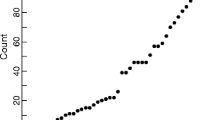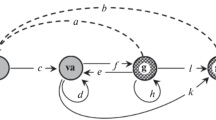Abstract
Density dependence and environmental stochasticity are both potentially important processes influencing population demography and long-term population growth. Quantifying the importance of these two processes for population growth requires both long-term population as well as individual-based data. I use a 30-year data set on a goshawk Accipiter gentilis population from Eastern Westphalia, Germany, to describe the key vital rate elements to which the growth rate is most sensitive and test how environmental stochasticity and density dependence affect long-term population growth. The asymptotic growth rate of the fully age-structured mean matrix model was very similar to the observed one (0.7% vs. 0.3% per annum), and population growth was most elastic to changes in survival rate at age classes 1–3. Environmental stochasticity led only to a small change in the projected population growth rate (between −0.16% and 0.67%) and did not change the elasticities qualitatively, suggesting that the goshawk life history of early reproduction coupled with high annual fertility buffers against a variable environment. Age classes most crucial to population growth were those in which density dependence seemed to act most strongly. This emphasises the importance of density dependence as a regulatory mechanism in this goshawk population. It also provides a mechanism that might enable the population to recover from population lows, because a mean matrix model incorporating observed functional responses of both vital rates to population density coupled with environmental stochasticity reduced long-term extinction risk of 30% under density-independent environmental stochasticity and 60% under demographic stochasticity to zero.







Similar content being viewed by others
References
Aars J, Ims RA (2002) Intrinsic and climatic determinants of population demography: the winter dynamics of Tundra voles. Ecology 83:3449–3456
Albon SD, Coulson TN, Brown D, Guinness FE, Clutton-Brock TH, Pemberton JM (2000) Temporal changes in the key factors influencing the population dynamics of red deer. J Anim Ecol 69:1096–1109
Andrewartha HG, Birch LC (1954) The distribution and abundance of animals. University of Chicago Press, Chicago
Arcese P, Smith JNM, Hochachka WM, Rogers CM, Ludwig D (1992) Stability, regulation and the determination of abundance in an insular song sparrow population. Ecology 73:805–822
Benton TG, Grant A (1999) Elasticity analysis as an important tool in evolutionary and population ecology. Trends Ecol Evol 14:467–471
Benton TG, Grant A, Clutton-Brock TH (1995) Does environmental stochasticity matter? Analysis of red deer life-histories on Rum. Evol Ecol 9:559–574
Bezzel E, Rust R, Kechele W (1997) Revierbesetzung, Reproduktion und menschliche Verfolgung in einer Population des Habichts Accipiter gentilis. J Orn 138:413–441
Burnham KP, Anderson DR (1998) Model selection and inference: a practical information-theoretic approach. Springer, New York
Caswell H (2001) Matrix population models, 2nd edn. Sinauer Associates, Sunderland
Clutton-Brock TH, Guinness FE, Albon SD (1982) Red deer: behaviour and ecology of two sexes. University Press, Chicago
Clutton-Brock TH, Major M, Guinness FE (1985) Population regulation in male and female red deer. J Anim Ecol 54:831–846
Clutton-Brock TH, Major M, Albon SD, Guinness FE (1987) Early development and population dynamics in red deer. 1. Density dependent effects on juvenile survival. J Anim Ecol 56:53–67
Cooch EG, White G (1998) Using MARK—a gentle introduction. http://www.canuck.dnr.cornell.edu/mark/
Coulson T, Catchpole EA, Albon SD, Morgan BJT, Pemberton JM, Clutton-Brock TH, Crawley MJ, Grenfell BT (2001) Age, sex, density, winter weather, and population crashes in Soay Sheep. Science 292:1528–1531
Coulson T, Rohani P, Pascual M (2004a) Skeletons, noise and population growth: the end of an old debate? Trends Ecol Evol 19:359–364
Coulson T, Guinness FE, Pemberton JM, Clutton-Brock TH (2004b) The demographic consequences of releasing a population of red deer from culling. Ecology 85:411–422
Cramp S, Simmons KEL (1980) Handbook of the birds of Europe, the Middle East and North Africa. Oxford University Press, Oxford
Cushing JM (1998) An introduction to structured population dynamics. SIAM Soc Ind Appl Math
de Kroon H, van Groenendael J, Ehrlen J (2000) Elasticities: a review of methods and model limitations. Ecology 81:607–618
Eberhardt LL (1977) Optimal policies for the conservation of large mammals, with special reference to marine ecosystems. Environ Conserv 4:205–212
Eberhardt LL (2002) A paradigm for population analysis of long-lived vertebrates. Ecology 83:2841–2854
Elton CS (1924) Periodic fluctuations in the number of animals: their cause and effects. Br J Exp Biol 2:119–163
Ferguson-Lees J, Christie DA (2001) Raptors of the world. Christopher Helm, London
Fischer W (1983) Die Habichte. Neue Brehm-Bücherei, Wittenberg Lutherstadt
Forchhammer MC, Stenseth NC, Post E, Langvatn R (1998) Population dynamics of Norwegian red deer: density-dependence and climatic variation. Proc R Soc Lond B 265:341–350
Forslund P, Pärt T (1995) Age and reproduction in birds—hypotheses and tests. Trends Ecol Evol 10:374–378
Fryxell JM, Hussell DJT, Lambert AB, Smith PC (1991) Time lags and population fluctuations in white-tailed deer. J Wildl Manage 55:377–385
Gaillard JM, Festa-Bianchet M, Yoccoz NG (1998) Population dynamics of large herbivores: variable recruitment with constant adult survival. Trends Ecol Evol 13:58–63
Gaillard JM, Festa-Bianchet M, Yoccoz NG, Loison A, Toigo C (2000) Temporal variation in fitness components and population dynamics of large herbivores. Ann Rev Ecol Syst 31:367–393
Glutz von Blotzheim U, Bauer K, Bezzel E (1971) Handbuch der Vögel Mitteleuropas, vol IV. Aula-Verlag, Wiesbaden
Grant A, Benton TG (2000) Elasticity analysis for density-dependent populations in stochastic environments. Ecology 81:680–693
Grenfell BT, Wilson K, Finkenstädt BF, Coulson TN, Murray S, Albon SD, Pemberton JM, Clutton-Brock TH, Crawley MJ (1998) Noise and determinism in synchronised sheep dynamics. Nature 394:674–677
Kennedy PL (1997) The northern goshawk (Accipiter gentilis atricapillus): is there evidence of a population decline? J Raptor Res 31:95–106
Kenward RE, Marcström V, Karlbom M (1999) Demographic estimates from radio-tagging: models of age-specific survival and breeding in the goshawk. J Anim Ecol 68:1020–1033
Krüger O (2005) Age at first breeding and fitness in goshawk Accipiter gentilis. J Anim Ecol 74:266–273
Krüger O, Lindström J (2001a) Habitat heterogeneity affects population growth in goshawk Accipiter gentilis. J Anim Ecol 70:173–181
Krüger O, Lindström J (2001b) Lifetime reproductive success in Common Buzzard Buteo buteo: from individual variation to population demography. Oikos 93:260–273
Krüger O, Stefener U (1996) Nahrungsökologie und Populationsdynamik des Habichts (Accipiter gentilis) im östlichen Westfalen. Vogelwelt 117:1–8
Krüger O, Stefener U (2000) Populationsfluktuation und die Rolle der Reproduktion in einer Population des Habichts Accipiter gentilis. Populationsökol. Greifvogel Eulen 4:263–271
Krüger O, Liversidge R, Lindström J (2002) Statistical modelling of the population dynamics of a raptor community in a semi-desert environment. J Anim Ecol 71:603–613
Kruuk LEB, Clutton-Brock TH, Albon SD, Pemberton JM, Guinness FE (1999) Population density affects sex ratio variation in red deer. Nature 399:459–461
Kühnapfel O, Brune J (1995) Die Mauserfeder als Hilfsmittel zur Altersbestimmung und Individualerkennung von Habichten (Accipiter gentilis). Charadrius 31:120–125
Laaksonen T, Korpimäki E, Hakkarainen H (2002) Interactive effects of parental age and environmental variation on the breeding performance of Tengmalm’s owls. J Anim Ecol 71:23–31
Lande R, Engen S, Sæther BE, Filli F, Matthysen E, Weimerskirch H (2002) Estimating density-dependence from population time series using demographic theory and life-history data. Am Nat 159:321–337
Lande R, Engen S, Sæther BE (2003) Stochastic population dynamics in ecology and conservation. Oxford University Press, Oxford
Langvatn R, Albon SD, Burkey T, Clutton-Brock TH (1996) Climate, plant phenology and variation in age of first reproduction in a temperate herbivore. J Anim Ecol 65:653–670
Lebreton JD, Burnham KP, Clobert J, Anderson DR (1992) Modelling survival and testing biological hypotheses using marked animals: a unified approach with case studies. Ecol Monogr 62:67–118
Leirs H, Stenseth NC, Nichols JD, Hines JE, Verhagen R, Verheyen W (1997) Stochastic seasonality and nonlinear density-dependent factors regulate population size in an African rodent. Nature 389:176–180
Lotka AJ (1925) Elements of physical biology. Williams and Wilkins, London
Martin K (1995) Patterns and mechanisms for age-dependent reproduction and survival in birds. Am Zool 35:340–348
May RM (1973) Stability and complexity in model ecosystems. Princeton University Press, Princeton
Moffat CB (1903) The spring rivalry of birds. Irish Nat 12:152–166
Moran BJT (2000) Applied stochastic modelling. Arnold Press, London
Newton I (1986) The sparrowhawk T. & A. D. Poyser, Calton
Newton I (1989) Lifetime reproduction in birds. Academic, London
Newton I, Marquiss M (1982) Fidelity to breeding area and mate in sparrowhawks Accipiter nisus. J Anim Ecol 51:327–341
Newton I, Rothery P (1997) Senescence and reproductive value in sparrowhawks. Ecology 78:1000–1008
Nicholson AJ (1957) The self-adjustment of populations to change. Cold Spring Harb Symp Quant Biol 22:153–172
Nielsen JT, Drachmann J (2003) Age-dependent reproductive performance in Northern Goshawks Accipiter gentilis. Ibis 145:1–8
Oli MK, Armitage KB (2004) Yellow-bellied marmot population dynamics: demographic mechanisms of growth and decline. Ecology 85:2446–2455
Opdam P, Müskens G (1976) Use of shed feathers in population studies of Accipiter hawks (Aves, Accipitriformes, Accipitridae). Beaufortia 24:55–62
Ozgul A, Getz LL, Oli MK (2004) Demography of fluctuating populations: temporal and phase-related changes in vital rates of Microtus ochrogaster. J Anim Ecol 73:201–215
Pfister CA (1998) Patterns of variance in stage-structured populations: evolutionary predictions and ecological implications. Proc Nat Acad Sci USA 95:213–218
Reid JM, Bignal EM, Bignal S, McCracken DI, Monaghan P (2004) Identifying the demographic determinants of population growth rate: a case study of red-billed choughs Pyrrhocorax pyrrhocorax. J Anim Ecol 73:777–788
Roff DA (2002) The evolution of life histories, 2nd edn. Chapman & Hall, New York
Royama T (1992) Analytical population dynamics. Chapman & Hall, London
Rust R, Kechele W (1996) Altersbestimmung von Habichten Accipiter gentilis: Langfristige Vergleiche gemauserter Handschwingen. Orn Anz 35:75–83
Rutz C, Bijlsma RG, Marquiss M, Kenward RE (2006a) Population limitation in the northern goshawk in Europe: a review with case studies. Stud Avian Biol 31:158–197
Rutz C, Whittingham MJ, Newton I (2006b) Age-dependent diet choice in an avian top predator. Proc R Soc Lond B 273:579–586
Sæther BE (1990) Age specific variation on reproductive performance of birds. Curr Orn 7:251–283
Sæther BE, Bakke O (2000) Avian life history variation and contribution of demographic traits to the population growth rate. Ecology 81:642–653
Sæther BE, Ringsby TH, Røskaft E (1996) Life-history variation, population processes and priorities in species conservation: towards a reunion of research paradigms. Oikos 77:217–226
Sibly RM, Hone J (2002) Population growth rate and its determinants: an overview. Phil Trans R Soc Lond B 357:1153–1170
Stearns SC (1992) The evolution of life histories. Oxford University Press, Oxford
Struwe-Juhl B, Schmidt R (2002) Möglichkeiten und Grenzen der Individualerkennung von Seeadlern (Haliaeetus albicilla) anhand von Mauserfederfunden in Schleswig-Holstein (1955–2000). Corax 19:37–50
Sutherland WJ (1996) From individual behaviour to population ecology. Oxford series in ecology and evolution. Oxford University Press, Oxford
Tuljapurkar SD (1990) Population dynamics in variable environments. Lecture Notes in Biomathematics 85. Springer, New York
van Groenendael J, de Kroon H, Caswell H (1988) Projection matrices in population biology. Trends Ecol Evol 3:264–269
van Tienderen PH (1995) Life cycle trade-offs in matrix population models. Ecology 76:2482–2489
Volterra V (1926) Fluctuations in the abundance of a species considered mathematically. Nature 118:558–560
White GC, Burnham KP (1999) Program MARK: survival estimation from populations of marked individuals. Bird Study 46:S120–S139
Zang H, Heckenroth H, Knolle F (1989) Die Vögel Niedersachsens-Greifvögel. Naturschutz Landschaftspfl. Niedersachs. B, H. 2.3
Ziesemer F (1983) Untersuchungen zum Einfluß des Habichts (Accipiter gentilis) auf Populationen seiner Beutetiere. Beitr. Wildbiol. 2, Kronshagen
Acknowledgments
I am indebted to U. Ostermüller and U. Stefener who helped collecting data and to H. Caswell, T. Coulson, J. Jones, D. Krüger, J. Lindström, J. Reid and two anonymous referees for advice and comments on the manuscript. Fellowships from the EU (Marie Curie), Churchill College (Junior Research Fellowship) and the Royal Society (Research Fellowship) funded this study.
Author information
Authors and Affiliations
Corresponding author
Additional information
Communicated by Markku Orell.
Appendix
Appendix
Schematic representation of the mean matrix model and the entries used to parameterise it. Abbreviations are as follows: s survival probability, f fertility and b breeding probability.

Rights and permissions
About this article
Cite this article
Krüger, O. Long-term demographic analysis in goshawk Accipiter gentilis: the role of density dependence and stochasticity. Oecologia 152, 459–471 (2007). https://doi.org/10.1007/s00442-007-0677-3
Received:
Accepted:
Published:
Issue Date:
DOI: https://doi.org/10.1007/s00442-007-0677-3




